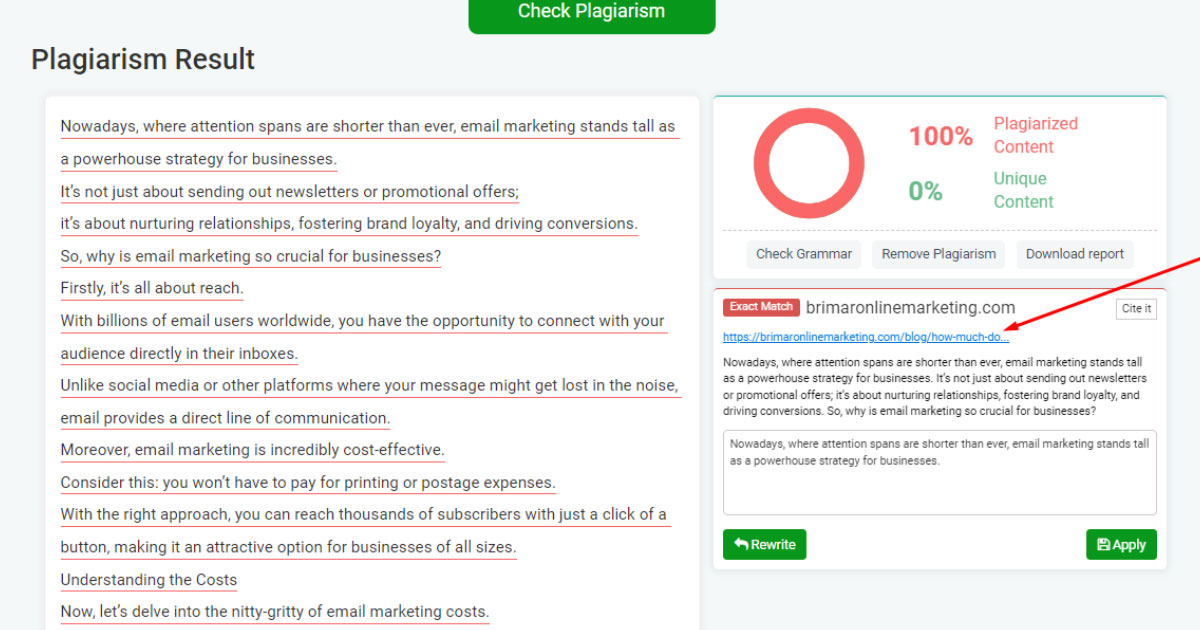
In the online world, content plagiarism is one of the most commonly faced issues by bloggers.
It is an unethical act that refers to copying and using another person’s content, concepts, ideas, or creative work without giving them any due credit.
Content plagiarism can either occur intentionally or unintentionally.
Due to its unethicalness, when plagiarized content is published on a website, it can greatly affect its online performance in several ways.
In this blog post, we will be discussing some of those details in detail.
Not just this, we will also explain how you can efficiently avoid plagiarism.
Ways Through Which Plagiarized Content Can Negatively Affect Website Performance
Plagiarized content can affect website performance in terms of rankings,
1. Increased Risk of Search Engine Penalties
Search engines like Google do not approve copied content.
If the search engine finds your site’s culprit, it will immediately penalize it.
The penalization here means, lower search rankings or sometimes NO SEARCH RANKINGS!
Apart from this, there are multiple other penalties that your website can get due to plagiarized content.
These include:
- Keyword level penalty: In this case, the search engine will remove all the ranked keywords of plagiarized content from its search.
- URL penalty: The name says all – the URL penalty will remove the permalink from the Search Engine Result Pages (SERPs).
- Site removal: This penalty is applied in severe cases – the entire website is removed from search results with almost zero chances of recovery.
Generally, Google decides the type of penalty based on the amount of plagiarized content a website contains.
Useful Note: It is usually said by SEO gurus that, 10% plagiarism in a single blog is allowed.
More than this will cause issues.
But remember, Google has never officially mentioned any acceptable plagiarism limit/percentage.
Need a Sales Funnel that Converts?
Struggling to turn clicks into customers?
A high-converting sales funnel could be the missing link. We’ll help you build a simple, straightforward, and effective funnel that guides your visitors step-by-step, so they take action, not just browse.
2. Reduced Chances of Attaining Good Backlinks
We all know that websites need to continuously attain high-quality backlinks from other domains to dominate search rankings.
This is because backlinks are a confirmed ranking factor.
However, when your site content is plagiarized, there is a strong chance that credible websites in your niche will avoid giving backlinks.
This is because giving a backlink to your site that is already on the verge of penalization due to plagiarism can also put the credible website performance at risk.
Ultimately, when your site does not receive good links from a highly authoritative site, it will definitely not be able to survive the search results, which is the primary goal.
3. Poor User Experience
Do you know?
Plagiarized content often lacks depth, creativity, flow, etc.
This gives users an indication that the content creators do not put any effort into providing useful information.
This then damages the trust of visitors, and they will be more likely to move on to the next one.
This movement from one site to another will not only increase the bounce rate but also trigger the search engine crawlers that something is wrong with your content, ultimately resulting in lower rankings.
4. Damaged Reputation & Difficulties in Building Brand Reputation
Obviously, when your website content is completely similar to the other ones, it will result in greatly damaging your reputation in the eyes of the targeted audience.
The bad reputation will then make it difficult for you to build a strong brand reputation in the market, which is crucial for online success.
Now, you have understood how copied content can negatively affect your site’s performance.
Let’s head towards the next part of our main topic.
How You Can Efficiently Avoid Plagiarism in the Content
There are multiple ways that you can take to prevent plagiarism, some of the most effective ones are as follows.
1. Use Plagiarism Checker
A plagiarism checker can greatly help in preventing the risk of plagiarism.
Let us explain how.
The tool will quickly scan your given content with millions of internet resources including blog posts, journals, research papers, e-books, and many more.
If any are found, it will highlight them along with their matched sources.
This highlighting will allow you to take the necessary steps to remove plagiarized pieces and make content unique for publication.
To demonstrate the working of a plagiarism checker in a better way, we copied content from our own article and checked it for duplication.
The results can be seen in the attachment below:

This is how you can easily figure out which pieces of content are duplicated and ultimately avoid them from being published on the website.
2. Consider Rewriting the Content in Your Own Words
Rewriting can also assist in avoiding content duplication.
It is a writing technique that involves restating already existing content in a unique way by making multiple changes.
The changes usually include the replacement of words, alteration of sentence structure, removal of unnecessary words, etc.
All these changes in the content will break the pattern of plagiarism, resulting in a 100% unique write-up.
For instance, below we have explained how you can efficiently rewrite the sentence below:
“Focus on creating valuable, informative, and well-written content that provides solutions to your audience’s problems.”
Now, let’s rewrite it.
“Pay attention to producing insightful, well-written, and valuable content that answers the issues your audience is facing.”
However, while rewrite, be sure the original meaning of your content remains unchanged.
3. Quoting
Quoting is basically a process of giving credit to the original author by writing the copied or plagiarized content within inverted commas (“”).
So, when you give credit to the original author, the risk of plagiarism in the content will be eliminated.
There are multiple specific words & phrases used while quoting external authors or sources.
These include “According to,” “Mentioned that,” “States that,” etc.
To provide you with a better understanding of this, check out the example below.
“According to Backlinko, there are almost 4.95 billion social media users in the world.”
This is how you can efficiently quote external sources/authors and avoid plagiarism.
4. Citing the Original Sources
Finally, citing is an academic technique that involves giving credit to the original author whose information has been used in your content.
The citing will indicate that your intentions were good, so plagiarism will not occur.
Thinking about how to cite sources?
For this, you will need to mention either the name of the original author or the complete source from where the information was taken.
The citation is mostly added after the copied text.
There are a number of citation styles available that you can use to avoid plagiarism.
Some of the most common and widely used ones include; APA, MLA, Chicago, etc.
Note: Citing will only work when one or two sentences of write-up are plagiarized.
In case too many sentences or paragraphs are plagiarized, then you will either have to rewrite them or remove them to avoid duplication.
So, these are some of the most effective ways through which you can easily avoid the risk of plagiarism in web content.
Additional Ways Plagiarism Can Harm Your Website and SEO Efforts
Beyond the well-known risks of plagiarism, website owners should understand how duplicate content impacts SEO rankings and long-term growth.
Search engines prioritize original content to provide users with the most valuable and informative results.
A site containing duplicate content confuses search engine algorithms, making it difficult to determine which page should rank higher.
One of the most serious consequences of content plagiarism is a drop in organic traffic.
If search engines detect copied material across multiple web pages, they may devalue or altogether remove those pages from search results.
This significantly reduces visibility, making it harder for a website to attract potential customers.
Another negative impact of plagiarism is the erosion of a brand’s reputation.
Visitors expect high-quality content that provides unique insights or solutions.
If they realize that the material has been copied from another original source, they may lose trust in the website, increasing bounce rates and reducing engagement.
For businesses relying on content marketing, maintaining plagiarism-free content is a best practice that ensures credibility and long-term success.
Copying from online sources without proper attribution does more harm than good, as it may lead to legal consequences that can damage a brand permanently.
Legal Issues Associated with Content Plagiarism
Aside from the SEO penalties, plagiarized content can lead to legal trouble.
Copyright laws protect original works, ensuring that content creators receive recognition for their work.
If a website owner is caught using copyrighted material without proper credit, they may face legal action, including fines, lawsuits, or forced content removal.
Copyright infringement applies to text, images, videos, and any other creative material.
Even if a content writer unintentionally copies from a single source, they can still be held accountable for accidental plagiarism.
This is why businesses and individuals should always perform manual checks or use plagiarism detection tools before publishing any content.
In extreme cases, companies or individuals who repeatedly engage in plagiarism may be banned from search engines altogether.
This means all their web pages would be removed from search rankings, making it nearly impossible to recover lost traffic and credibility.
Seeking legal advice before using someone else’s work is always a good idea to avoid potential copyright disputes.
How to Ensure Your Content is Plagiarism-Free
Following best practices for content creation is essential for maintaining strong SEO rankings and protecting your website from legal issues.
Below are some practical ways to ensure your website features plagiarism-free content:
1. Use Online Plagiarism Checkers
One of the easiest ways to detect copied material is by using online plagiarism checkers or plagiarism detection software.
These online tools scan the internet to find instances of plagiarism, ensuring that your content remains unique.
Popular plagiarism detection tools compare text with billions of online sources, helping you avoid potential SEO and legal trouble.
2. Always Give Proper Credit
When using information from an original source, it is crucial to provide proper citation.
This means attributing the content to its creator by using quotation marks for direct quotes and linking back to the source material.
Without proper attribution, even a few copied sentences can have serious consequences for your SEO content and brand’s reputation.
3. Focus on Creating Unique Content
The best way to improve search engine ranking is by publishing unique content that offers fresh insights.
Avoid relying too much on a single source for research.
Instead, combine ideas from multiple references, ensuring that your own content stands out.
Using artificial intelligence tools can help generate ideas, but human creativity is irreplaceable for high-value content marketing.
4. Implement Canonical Tags for Duplicate Pages
Sometimes, websites naturally have duplicate content, such as product descriptions, categories, or similar blog posts.
In these cases, adding canonical tags helps search engines understand which version should be indexed.
This prevents unintentional SEO penalties and allows businesses to maintain a strong SEO content strategy.
5. Stay Updated with Copyright Laws
As a website owner, staying informed about copyright laws and how they apply to digital content is essential.
Different types of content require other forms of attribution.
Understanding various forms of plagiarism including verbatim copying, paraphrasing without citation, and self-plagiarism, can prevent future legal issues.
Why Plagiarism-Free Content is a Long-Term SEO Strategy
If you want your website to thrive in the long run, prioritizing original work is the best investment.
Search engines reward websites that consistently produce high-quality content, leading to better rankings and greater visibility.
When visitors see that a website values authenticity, they are likelier to engage, share, and return for future content.
Additionally, maintaining a plagiarism-free content strategy strengthens a site’s credibility.
When businesses establish themselves as thought leaders, they naturally attract potential customers who trust their expertise.
This, in turn, leads to higher conversions, stronger customer relationships, and overall business growth.
Wrapping Up
Plagiarism in web content can negatively impact website performance.
For instance, it results in lower rankings, poor reader experience, etc.
In this blog, we have explained these in detail.
Besides this, we have discussed how you can efficiently avoid duplication in your website site and increase the overall chances of dominating the SERP rankings.
Our Digital Marketing Services Have Helped Our Clients Increase Their Revenue!
“I highly recommend Brimar if your looking to grow your online business. You will be satisfied with the high level of expertise and high quality of services. It has helped my business grow by leaps and bounds.”
CEO

